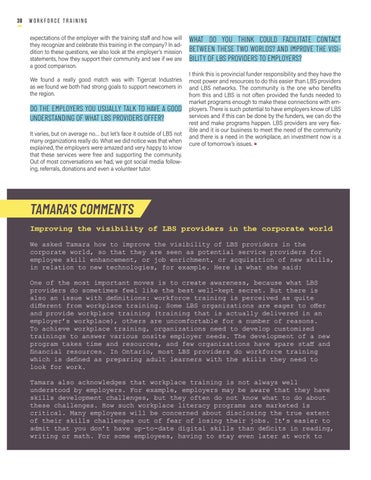38
Workforce training expectations of the employer with the training staff and how will they recognize and celebrate this training in the company? In addition to these questions, we also look at the employer’s mission statements, how they support their community and see if we are a good comparison. We found a really good match was with Tigercat Industries as we found we both had strong goals to support newcomers in the region.
DO THE EMPLOYERS YOU USUALLY TALK TO HAVE A GOOD UNDERSTANDING OF WHAT LBS PROVIDERS OFFER? It varies, but on average no… but let’s face it outside of LBS not many organizations really do. What we did notice was that when explained, the employers were amazed and very happy to know that these services were free and supporting the community. Out of most conversations we had, we got social media following, referrals, donations and even a volunteer tutor.
WHAT DO YOU THINK COULD FACILITATE CONTACT BETWEEN THESE TWO WORLDS? AND IMPROVE THE VISIBILITY OF LBS PROVIDERS TO EMPLOYERS? I think this is provincial funder responsibility and they have the most power and resources to do this easier than LBS providers and LBS networks. The community is the one who benefits from this and LBS is not often provided the funds needed to market programs enough to make these connections with employers. There is such potential to have employers know of LBS services and if this can be done by the funders, we can do the rest and make programs happen. LBS providers are very flexible and it is our business to meet the need of the community and there is a need in the workplace, an investment now is a cure of tomorrow’s issues. ■
TAMARA'S COMMENTS Improving the visibility of LBS providers in the corporate world We asked Tamara how to improve the visibility of LBS providers in the corporate world, so that they are seen as potential service providers for employee skill enhancement, or job enrichment, or acquisition of new skills, in relation to new technologies, for example. Here is what she said: One of the most important moves is to create awareness, because what LBS providers do sometimes feel like the best well-kept secret. But there is also an issue with definitions: workforce training is perceived as quite different from workplace training. Some LBS organizations are eager to offer and provide workplace training (training that is actually delivered in an employer’s workplace), others are uncomfortable for a number of reasons. To achieve workplace training, organizations need to develop customized trainings to answer various onsite employer needs. The development of a new program takes time and resources, and few organizations have spare staff and financial resources. In Ontario, most LBS providers do workforce training which is defined as preparing adult learners with the skills they need to look for work. Tamara also acknowledges that workplace training is not always well understood by employers. For example, employers may be aware that they have skills development challenges, but they often do not know what to do about these challenges. How such workplace literacy programs are marketed is critical. Many employees will be concerned about disclosing the true extent of their skills challenges out of fear of losing their jobs. It’s easier to admit that you don’t have up-to-date digital skills than deficits in reading, writing or math. For some employees, having to stay even later at work to





